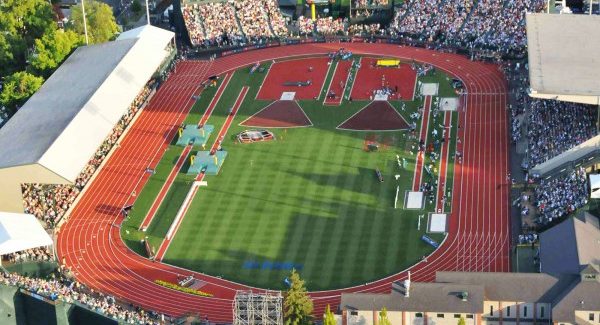NCAA Championships: Thoughts on Day 2
Jesse Squire | On 10, Jun 2016
Random thoughts, news and views on day 2 of the NCAA track and field championships in Eugene, Oregon…
If you want full results, here’s your link.
Complete recaps are available from the USTFCCCA, The Oregonian, the Eugene Register-Guard, and Let’s Run.
Two collegiate records in 11 minutes
Ole Miss’ Raven Saunders was the prohibitive favorite entering the shot put last night, despite a poor 12th-place showing at the NCAA indoor championships. Other than that, she has rarely if ever lost to a collegiate thrower and holds the national high school and US Junior records. In round #5 she hit a big 19.33 meters (63′ 5″), which broke the collegiate record.
Just over ten minutes later, Texas A&M’s Maggie Malone stepped on adjacent javelin runway, also in the fifth round, and let loose a 62.19 meter throw (204′ 0″), also a collegiate record.
Saunders is now #7 in the world over the Olympic qualifying period (May 1 of last year to present). Malone is a bit further back at #28, but notably is the third American to achieve the Olympic qualifier.
What were the old records?
What the old records were depends on who you ask, because the NCAA does not keep collegiate records.
For decades, the job of maintaining collegiate records fell to Track and Field News, but now the USTFCCCA has gotten into the action. There are places where they don’t agree.
For example, the USTFCCCA’s previous shot put record was 18.99 meters (62′ 3¾”) by Arizona’s Meg Ritchie in 1983. TFN’s record was Saunders’ own 19.23 meters (63′ 1¼”) from the indoor season, because their record list is “comprehensive”, i.e., indoors or out.
Another place they don’t agree is on the men’s 800 meters. The USTFCCCA lists it as 1:44.3 by Kansas’ Jim Ryun in 1966, while TFN lists it as 1:44.55 by George Mason’s Julius Achon in 1996. Why the difference? I’m going to assume that it’s because Ryun’s official time was 1:44.9 for 880 yards, and no official time was taken at 800 meters (1:44.3 is an estimate). The other possible reason is because Ryun wasn’t using a year of eligibility in 1966; he was a freshmen and they generally weren’t eligible for college athletics back then.
Oregon does not have their ducks in a row
The Oregon Ducks are experiencing one problem after another in their pursuit of a second straight NCAA outdoor championship. Sprint star Jasmine Todd quit the team two weeks ago. Another sprint star, Hannah Cunliffe, appeared to injure (or reinjure) a hamstring in last night’s 100 meter semis. And the evening ended with a dropped baton and a DNF in the 4×400 relay. The last few weeks haven’t been good in the PR department, either.
At this point, it would take a minor miracle combined with an Arkansas implosion for Oregon to successfully defend their national championship.
Attendance
I keep attendance records for just about every domestic competition that releases the information, in part because no one else does.
Attendance for the first two days was 9,201 and 9,027. How does that compare to past years?
Viewed myopically, it’s just OK.
| Year | Wed | Thu |
| 2016 | 9,201 | 9,027 |
| 2015 | 9,627 | 10,015 |
| 2014 | 9,165 | 9,903 |
| 2013 | 9,001 | 9,835 |
Viewed with a longer perspective, it’s pretty good.
| Year | Host | Wed | Thu |
| 2016 | Oregon | 9,201 | 9,027 |
| 2015 | Oregon | 9,627 | 10,015 |
| 2014 | Oregon | 9,165 | 9,903 |
| 2013 | Oregon | 9,001 | 9,835 |
| 2012 | Drake | 4,052 | 4,877 |
| 2011 | Drake | 5,713 | 7,187 |
| 2010 | Oregon | 9,891 | 11,172 |
| 2009 | Arkansas | 4,816 | 5,206 |
| 2008 | Drake | 8,841 | 9,618 |
| 2007 | Sacto St | 6,508 | 6,617 |
| 2006 | Sacto St | 4,629 | 5,417 |
| 2005 | Sacto St | 4,017 | 4,517 |
Other than 2008, which was the first time since 1970 that Drake hosted the meet, weekday attendance at Oregon is roughly double that of anywhere else.
It would be a mistake, however, to think that good attendance just happens naturally at Oregon. Turnout was very ordinary for the NCAAs at Oregon in 1991, 1996 and 2001, especially on Wednesday and Thursday (it ranged between 3,688 and 5,626). Attendance is good at Oregon because they work at it. They didn’t in the 90s and it showed, but they do now.
Random observation
If the Razorbacks do win the women’s championship, that means that Oregon won indoor championships at Arkansas (not this year, but several times in other years) and Arkansas will have won the outdoor championship at Oregon.

















Submit a Comment